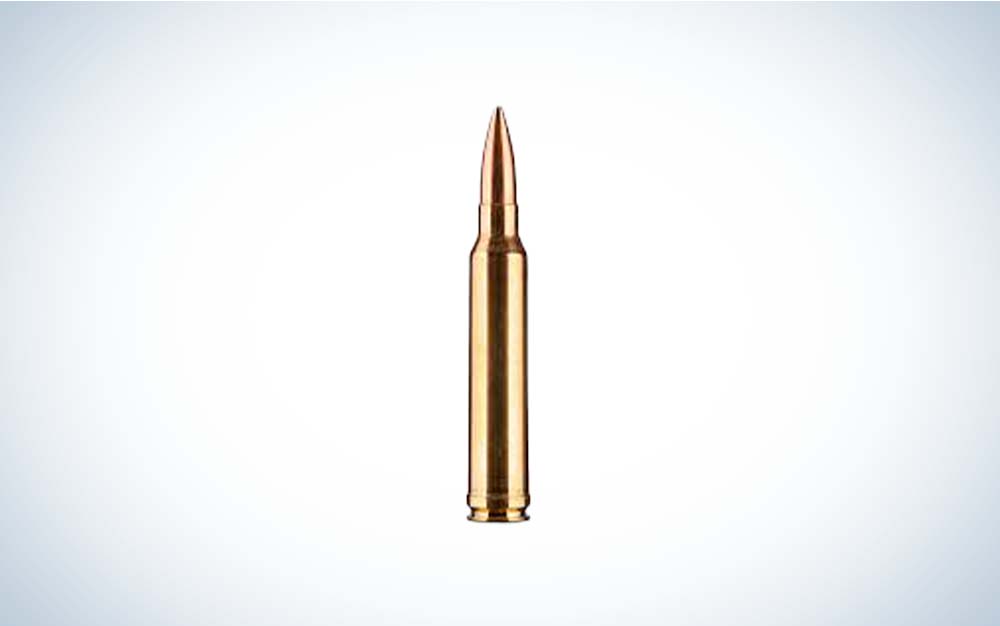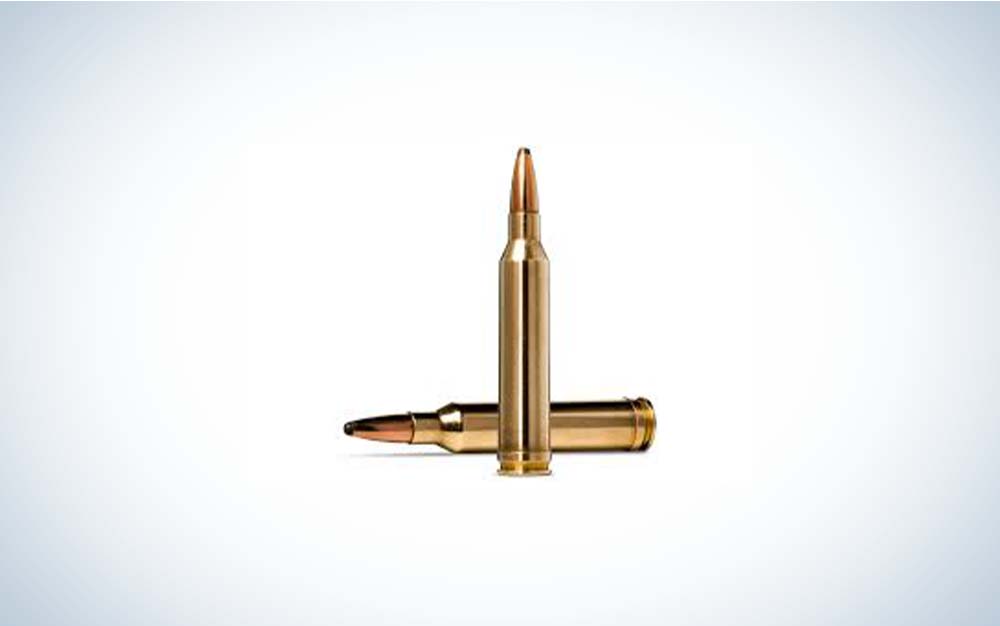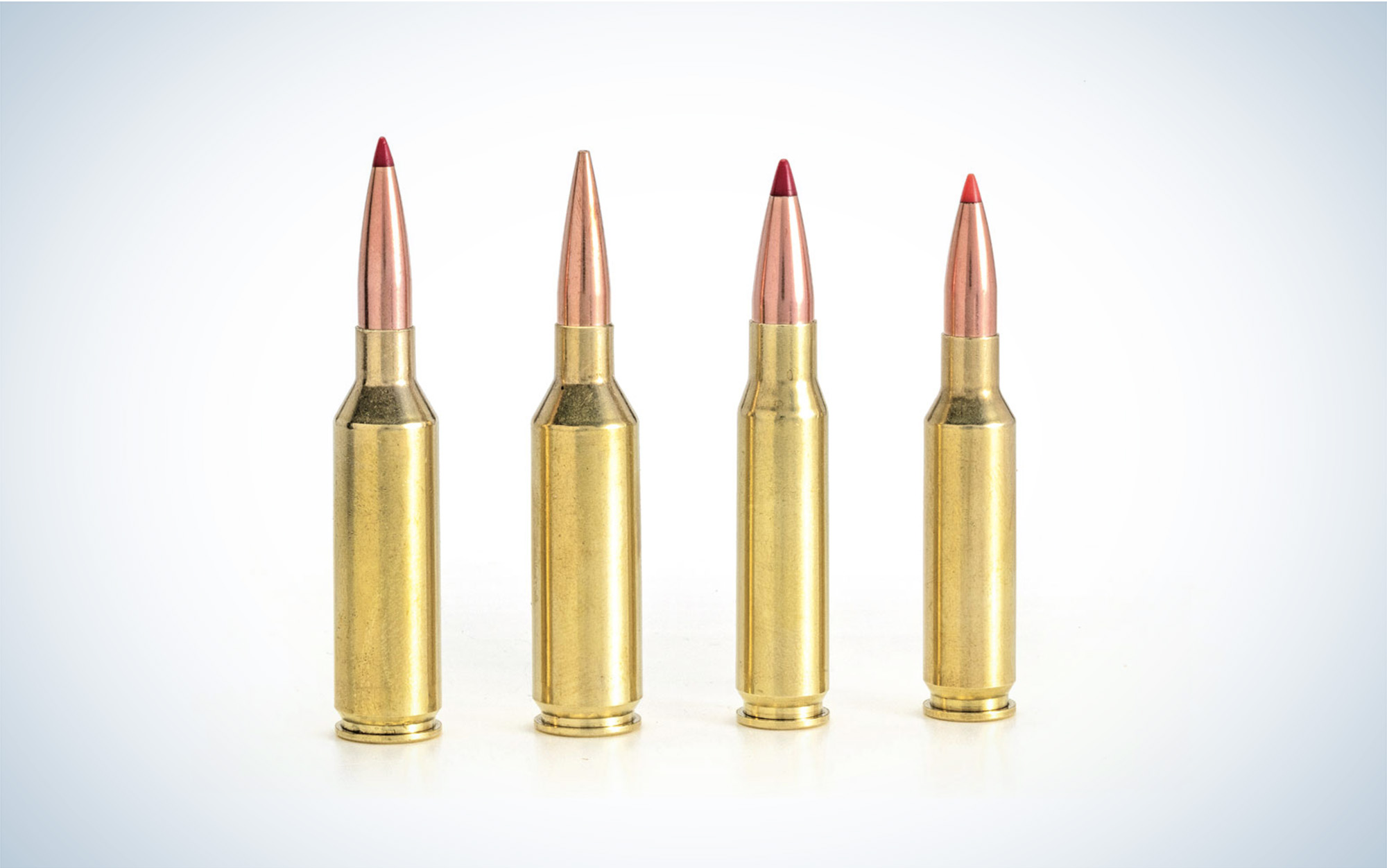We may earn revenue from the products available on this page and participate in affiliate programs. Learn More ›
Written By
Ron Spomer
Updated Aug 8, 2023 4:23 PM
Elk are a big deal because they’re a big deer, and thus require big elk calibers. Elk carry enough venison on the hoof to suggest a big cartridge and big bullet. Use enough gun, enough caliber, and enough cartridge and bullet to invite them to dinner. But not so much that you’re afraid to shoot it.
This is the unfortunate trade off. Any cartridge in a caliber big enough to hit an elk hard hits you hard, too. Fear of recoil ruins the best laid plans of mice and men, and that’s why choosing the best elk cartridge requires thorough research and honest assessment. This review can help with that. Let me confess that I, too, consider these “best caliber” articles overdone and quite subjective, but by hashing them over and over, we gain insights.
Before we begin, you should understand that this is a round up of the best calibers and cartridges for elk, not necessarily the most popular ones. And I write “calibers and cartridges” because “caliber” means the diameter of the bore. “Cartridge” means the case that holds the powder that drives the bullet. The .30/30, .300 Savage, .30/06, .300 Win. Mag., and .300 RUM are all 30 calibers, but significantly different 30-caliber cartridges. Hunters typically but incorrectly use the best elk “calibers” to mean cartridge, but I’ll use calibers for the sake of this review.
The final arbiters of the Best elk calibers are you and the elk, but here are my top five that I chose for their balance of power, reach, recoil, trajectory (drop and drift,) availability, affordability in reasonably compact, light, “mountain ready” rifles.
- 7mm Rem. Mag. (Go .280 AI in the lightest rifles)
- .300 Win. Mag. (With the right 200-grain bullet, every bit as effective as the .338 Win. Mag.)
- .338 Win. Mag.
- .30/06 Springfield (You can’t not recognize the undeniable capability of this old war horse.)
- .270 Winchester (Just too successful a track record to ignore. Replace with the 6.8 Western or 6.5 PRC if you must go modern.)
Best Elk Hunting Calibers: Reviews and Recommendations
Best Balanced: .338 Winchester Magnum
The general consensus is that this old, belted magnum is the best caliber for elk hunting. That is, the best of the best for terminating elk without beating up shooters. It has a near perfect balance of length, width, power, and recoil. With the right bullets, it can actually hit harder than the 375 H&H Magnum at longer ranges.
The .338 Win. Mag. arrived in 1958 as a short magnum derived from the .375 H&H belted magnum case. “Short” in the Elvis era meant standard or 30/06 length: 3.340-inches overall cartridge length, down from the 3.6-inches of the parent cartridge. This meant the .338 Win. Mag. could be chambered in the standard Model 70 rifles of the day and eventually most other standard length bolt action rifles. Think Remington M700s, Savage M110s, Ruger M77s, and even the Browning Autoloading Rifle. Any rifle strong enough to contain the 7mm Rem. Mag. or .264 Win. Mag. will handle the .338 Win. Mag. because maximum average chamber pressure is 64,000 psi. That’s 1,000 psi less than the little .22/250 Remington.
Winchester’s original loadings included a 200-grain bullet rated 3,000 fps, a 250-grain at 2,700 fps, and a heavy 300-grain at 2,450 fps from 24-inch barrels. Today most ammo makers also offer 225-grain bullets in a variety of controlled expansion configurations that retain mass well enough to penetrate better than the original 250-grain cup/core styles while delivering equal, sometimes more muzzle energy thanks to higher muzzle velocity. Most 225-grain factory loads are rated 2,750 to 2,800 fps, enough velocity to put about 3,900 ft-lb of energy into that little bullet. In comparison a 250-grain slug at 2,600 fps will churn up just 3,750 ft-lb.
With good form, a boat tail 225-grain .338 slug should rate a B.C. in the mid .4s to low .5s, good enough to provide maximum point blank range of 320 to 340 yards on a 10-inch target zone. At 300 yards that bullet should still carry nearly 2,700 ft-lb energy, which is close to what a 180-grain .308 Winchester coughs up at the muzzle. Elk don’t like any of this.
But elk stopping performance typically comes with a price: recoil. The 225-grain load in an eight-pound rifle should generate about 40.8 ft-lb of recoil energy. Heft up to a 10-pound rifle and kick will calm to just 32.7 ft-lb.
Handloaders report optimum performance with a sleek, high B.C., 225-grain bullet pushed to an impressive 2,882 fps from a 24-inch barrel. Zeroed 3.3 inches high at 100 yards, that projectile will drop just two inches at 300 yards, deflect just five inches in a 10 mph right angle wind, and cling to 2,866 ft-lb energy. You’ll appreciate that kind of performance if you can handle the recoil.
Other .338 Options
The 33-caliber has become a crowded family, and all members are more than suitable for elk. Some shoot faster and hit harder than the .338 Win. Mag., some less. Throw the excellent 32 calibers into the mix, the .325 WSM and 8mm Rem. Mag., and elk hardly know the difference. At the light end is the .338 Federal, the .308 Winchester case necked up. It’ll only hit 2,400 fps or so with a 225-grain bullet, so the 200- and 210-grain slugs might be the better choice. At 2,500 fps and a B.C. of .414 or so, the 210-gr. from a .338 Federal should deliver 1,711 f-p energy at 300 yards and drop just nine inches.
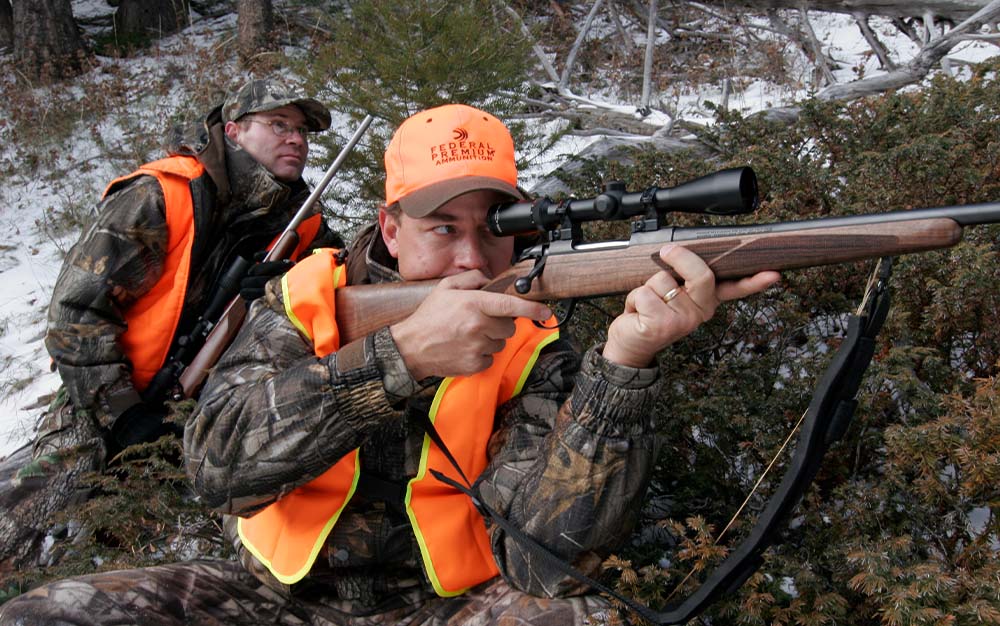
The .338/06 adds about 200 fps muzzle velocity for about two inches less drop at 300 yards and roughly 300 ft-lb more punch. Recoil is about 30-percent less than the .338 Win. Mag.
If recoil isn’t a concern, you can slide up the power charts via the 33 Nosler, .340 Wby. Mag., .338 RUM, .338 Lapua Mag., and massive .338-378 Wby. Mag. I warned you this is a big family. But the .338 Win. Mag. retains the title of best balanced elk caliber in it. Ammo is easier to find in a greater variety of bullet weights and styles, too.
Best All Around: .300 Winchester Magnum
This little brother to the .338 Win. Mag. hatched five years later and gave big brother a real run for his money. Weatherby’s .300 magnum had been dazzling magnum fans since the mid 1940s, but it was a full-length magnum caliber available only in expensive custom or Weatherby Rifles. Winchester borrowed the same basic belted magnum case, blew out the walls, pushed the 25-degree shoulder forward, shortened overall length to .30/06 standard, and created a powder reservoir holding about 90 grains of water. It’s a 3.34-inch magnum cartridge that fits the same standard-length action rifles as the .338 Win. Mag. but doesn’t kick as hard. Sales bloomed immediately when it released.
In 1963, everyone knew the all-American .30/06, so they had a benchmark against which to judge this belted magnum throwing the same familiar bullets 200 fps faster. No rough-and-tough manly man in the 1960s was going to admit he couldn’t handle that. And he could get it in affordable rifles from several manufacturers.
This was and is one key to the .300 Win. Mag’s. worldwide popularity. Because Winchester didn’t insist on the caliber being proprietary, anyone could load and chamber for it. It was and still is Everyman’s (and woman’s) 30 magnum. It hits harder than the .30/06 and even the old .300 H&H Magnum without as much recoil as the .338. What’s not to like? Well, bullet weight, perhaps?
Many an elk hunter has suggested the .300 Win. Mag. cannot measure up to the .338 Win. Mag. because the latter rolls out those wide, .338-inch diameter 250-grain bullets. True. But .300 Win. Mag. bullets, weight to weight, have a higher SD for potentially better penetration. And while most heavy .300 Win. Mag. loads top out with 200-grain bullets, 210-, 220-, and 230-grain options are available. In the past, you had to handload to get these, but long-range shooters have created sufficient demand that many ammo makers now offer factory ammo featuring bullets heavier than 200-grains. Nevertheless, the 180-grain has long been the standard with elk hunters. Most factory loads from a 24-inch barrel are rated 2,960 fps. That’s good enough for 3,500 ft-lb muzzle punch. A high B.C. bullet like the Swift Scirocco will retain 2,350 ft-lb at 400 yards, 1,500 ft-lb clear out at 600 yards. If zeroed three inches high at 100 yards, that slug should drop just 1.7 inches at 300 yards and deflect just 5.7 inches in a 10 mph right angle wind.
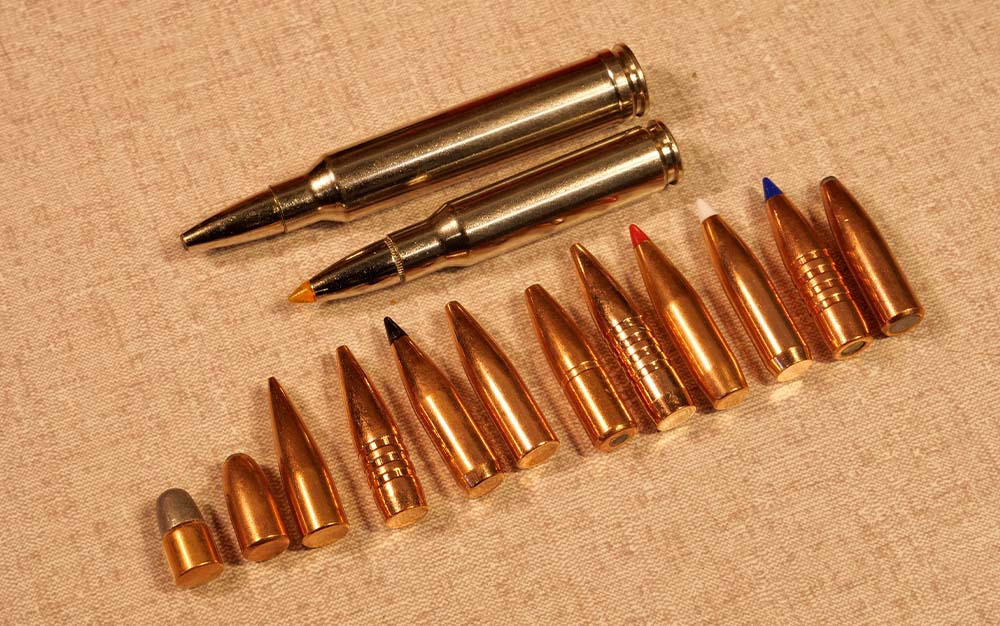
Slide up to some of the new 190-gr. bullets with B.C. numbers hitting .590 or so, keep velocities at 3,000 fps with carefully built handloads, and 300-yard drop is only 2.3 inches, wind deflection 4.7 inches, retained energy 2,700 ft-lb. Those are better trajectory numbers than many .338 Win. Mag. loads. Add in the lighter recoil of the .300 Win. Mag., and you understand why it’s not just the most popular .300 magnum of all time, but one of the best all-round elk calibers of all time.
Other .30-caliber Options
There are plenty of other .30-calibers for hire. Start with the .30/30 Winchester and climb until your nose bleeds. Thirty-calibers have been sending elk to the table for more than 125 years. As with any caliber, the lighter the bullet and lower the muzzle velocity, the easier the rifle is to handle and the closer you should get before taking your shot. With the right bullet and .308 hunting rifle, the ubiquitous .308 Winchester is more than adequate out to 300 yards where a high B.C. 180-gr. launched 2,600 fps will still be churning some 1,800 ft-lb energy. The right .30/06 load should add 100 fps velocity and 100 ft-lb energy.
After those stalwarts comes a blizzard of .30-calibers that claw their way up the power scale. Choosing one of them comes down to personal preference and the kinds of rifles one likes to carry. Some .30-calibers work best in lever actions, some in short actions, some in full magnum actions. Some come in ultralight rifles for easy mountain hunting, some in extra heavy platforms for stand hunting or longer range shooting. A few more calibers throwing those famous .308 bullets include the .300 Ruger Compact Magnum, .300 SAUM, .300 WSM, .30/308 Norma Mag., .300 H&H, 30 Nosler, .300 Wby. Mag., .300 RUM, and .30-378 Wby. Mag. Your taste in rifle weight, mass, and recoil will color your choices. Elk won’t care one way or the other so long as you use a suitable bullet and park it properly.
The Next Best: 7mm Remington Magnum
If the .338s are the best caliber on the upper end for elk, the 7mms are the best at the lower end. Certainly the .270s and 6.5mms can and do take elk annually, but one would be hard pressed to recommend them as optimum. The smaller the bullet, the higher its quality and the more precise its deposit must be. Many argue this about the .28-calibers, too, but the old 7mm Remington Magnum remains, since its inception in 1962, the most popular and effective 7mm elk caliber in the mountains. Believe it or not, with the right bullet, it can hang right with the .300 Win Mag without the recoil. For example:
Fire a Nosler 168-gr. AccuBond Long Range or a comparable bullet with its high B.C. of .616 from a 24-inch barrel 3,000 fps and a 190-gr. high B.C. slug from the .300 Win. Mag. at 3,000 fps. Zero both three inches high at 100 yards and at 400 yards they both drop 11.3 inches and deflect about 8.5 inches in that 10 mph breeze. The 190-gr. bullet will carry about 250 ft-lb more energy. By 600 yards that energy advantage will have dropped to just 180 ft-lb. Given that 1,500 ft-lb is considered “elk power,” both projectiles are golden. This takes us back to the launch. In eight-pound rifles, the 7mm Rem. Mag. will kick with 29.3 ft-lb, and the 300 will slap you with 37 ft-lb.
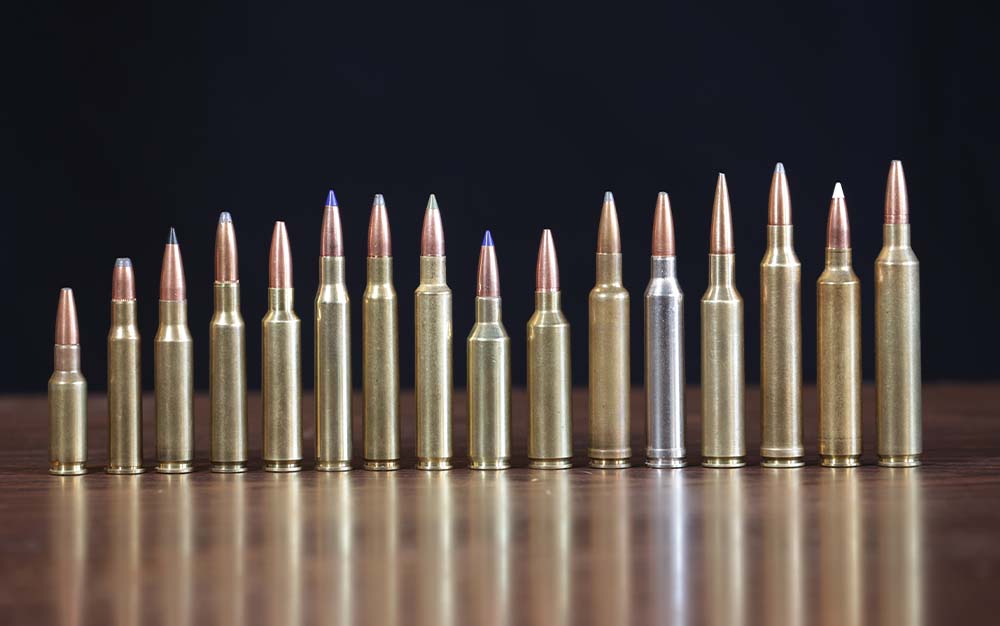
Lighter recoil matched to .300 Win. Mag. trajectory may explain how the 7mm Rem. Mag. buried one Winchester magnum and created another. When it first came out in 1962, it sent the then four-year-old .264 Winchester Magnum into a tailspin. Here was the same basic belted magnum case, but the 7mm threw bullets as heavy as 175 grains. The .264 topped out at 140-grains. It worked fine for long range deer hunting, but elk hunters wanted more bullet. The immediate success of the 7mm Rem. Mag. may have inspired Winchester to bring out its marvelous .300 magnum the very next year.
There is a persistent myth flying about that the 7mm Rem Mag shoots “too fast.” Many claim its bullets don’t have time to open. Nonsense. I’ve just shown that it’s no faster than the .300 Win. Mag., and no one howls about that being too fast. Any real or perceived failure of the 7mm Rem. Mag. can be laid at the feet of the shooter or the bullet used. Bullets engineered to expand at 7mm terminal velocities are the ticket, and there are plenty of them. Hit an elk with a 175-gr. .284-inch bullet or a 180-gr. .308-inch diameter bullet carrying 1,500 ft-lb energy and I doubt they’ll notice any difference.
Other 7mms
The 7mm family hatched around 1892 with the 7x57mm Mauser and has since grown to fifteen or more. The old 7×57 is itself a proven elk getter. After all, this was the round Bell used to collect 800 elephants and untold numbers of Cape buffalo. The right bullet in the right place. So match your 7mm elk dreams to your recoil tolerance and select among this big family. The .280 Ackley Improved is hot these days, flying about 100 fps behind the 7mm Rem. Mag. The 28 Nosler and Remington Ultra Magnum adds about 250 fps to the Rem. Mag. The 7 WSM and 7 SAUM just about match it in handier short action rifles. We have an embarrassment of choices in 7mms, and elk don’t like any.

The 6.5 Calibers
Despite the age and reputation of the 6.5×55 Swede cartridge across Europe, the 26-calibers have never been a go to for elk in North America. However, since the 2007 advent of the 6.5 Creedmoor, they’ve taken the target and hunting world by storm. But I still don’t consider them a top pick for elk just because, well, larger calibers provide a slight edge. That said, dozens, nay hundreds of elk are layed low each fall by careful application of the 6.5 Creedmoor, a near ballistic twin of the Swede. But if you’re going to this narrow caliber, choose one with more velocity than the Creedmoor. Fine options include the old .264 Win. Mag., 6.5 Weatherby RPM, 6.5-300 Wby. Magnum, 26 Nosler, and my choice for all-round balance in a short action rifle, the 6.5 PRC. This short-fat, looking remarkably similar to the 6.8 Western, adds around 200 fps to the best Creedmoor speeds, and that lets you shoot the same bullets with less drop, less wind deflection, and more energy on target. A 140- to 150-grain .264 driven to the same speeds as a .270 Win. throwing similar weight projectiles means you’re packing elk medicine.
More or Less
Calibers lighter and heavier than the 7mms through .338s can be considered excellent for elk. The old .270 Winchester has been hotly debated since 1925, yet it has been a favorite among thousands of elk pros. Faster models like .270 Wby. Mag., .270 WSM, and 27 Nosler step it up a few notches, and the 6.8 Western with its fast twist barrels nudges bullet weights to the upper end of the 7mm line up.
These days certain 6.5mms have been growing in popularity despite relatively light bullets and muzzle velocities well under 3,000 fps. But that doesn’t seem to matter. Good bullet design and placement seem to work just fine. Just be aware that shot angles and placement do become critical as bullet mass and energy decline.
On the other side of the caliber scale are the .35 Whelen (.30/06 necked up) and various .375s. Many elk hunters consider the old .375 H&H the ultimate elk medicine, but not everyone cares to handle their recoil or the kind of rifle mass that tames it. Still, any .37-caliber pushing 250- to 300-grain bullets faster than about 2,500 fps is going to lead to copious amounts of skinning and packing. Ditto the .416s, 44s, and 45s.
How to Choose the Best Elk Hunting Caliber
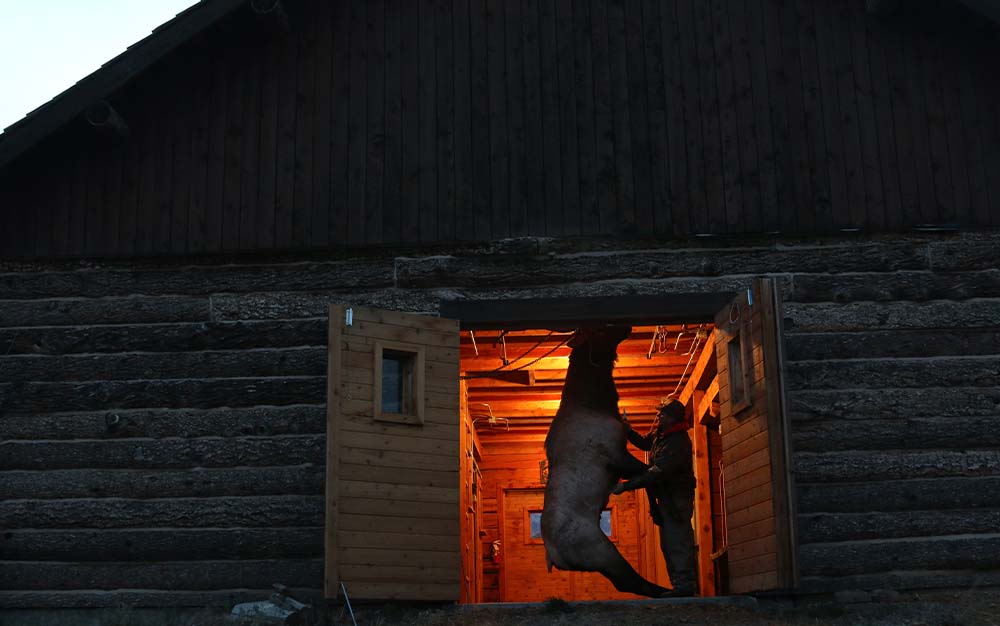
Selecting your perfect elk caliber hinges on you as well as the elk and the landscapes and habitat in which you’ll hunt them. Just as there’s a significant difference between a 22-year-old, 6-foot 4-inch athlete and a 50-year-old, 5-foot 7-inch accountant, there’s a huge difference between rolling prairies and 11,000-foot peaks poking above doghair stands of pine and spruce.
If you’re shopping for the perfect elk caliber/rifle, determine how much recoil you can tolerate without flinching and how much rifle weight you might enjoy packing. This will be influenced significantly by the terrain you’ll hunt. The easier the terrain, the heavier the hunting rifle you’ll be able to tolerate. The tougher the terrain, the lighter. Ditto rifle size. The tighter the cover, the shorter the rifle. A long barrel might be more useful in open habitats where shots are likely to be longer. Just make sure you have the best rifle for the terrain you intend to hunt.
These rifle weight/size considerations will influence cartridge size, especially length. Short action chamberings are likely to be in shorter, lighter rifles, so instead of a .338 Win. Mag., look at a .338 Federal, .358 Win., or even 7mm-08 Win. in a 22-inch barrel. If recoil doesn’t bother you, I’d look hard at the .300 WSM, .325 WSM, even the new 6.8 Western, agonize over a 24-inch barrel, and probably compromise with a 23-inch barrel.
If you anticipate hunting big, open country or canyonlands where shots could go long, the .300 and .338 magnums should be on your list. If you need to balance reach and punch with minimal weight, I’d look to the 7mm magnums pushing 150- to 175-grain bullets.
Obviously, there is plenty of leeway in all of this, and personal biases can play a big role. I know small-framed hunters who happily pay the gravitational price for packing Granddad’s M1886 Winchester lever-action in .45/70. But I also have a 6-foot 2-inch 20-something friend who climbs with a little 6.5 Creedmoor and lays out 6×6 bulls with single shots at 400 yards.
A final consideration these days is availability of guns and ammo. It might be impossible to find the rifle you want and darn tough to find factory loads to feed it. Unless you work with a custom gun builder and handload, study factory options before choosing.
Clearly there is no one right answer. Or even ten. Think it all through carefully before choosing. And realize that after a hunt or choice you might want to choose differently. That’s ok. “Live and learn” is a common aphorism for a reason.
Final Thoughts on the Best Elk Hunting Calibers
My picks for the best elk hunting calibers are what I consider the best, not the most popular. They’re all proven to kill elk with proper shot placement and are available in rifles you won’t mind carrying in the mountains.

